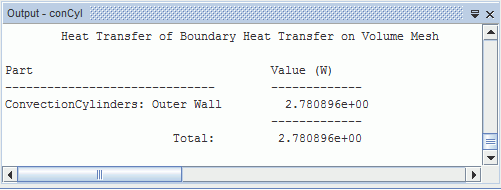Comparing Results to Experimental Data
This part of the tutorial compares results and data using equivalent conductivity.
Kuehn and Goldstein reported their experimental and numerical results in the form of an equivalent conductivity. This equivalent conductivity is defined as the ratio of the actual heat transfer measured (or predicted) across the annulus to the heat transfer that would be obtained by pure conduction alone. That is:
For concentric cylinders, is defined as:
For the case being considered in this tutorial, Kuehn and Goldstein obtained an equivalent conductivity of 2.58.
- To begin evaluating conductivity, calculate the conductive heat transfer based on Eqn. (5249) using values provided earlier in your setup. This comes out to .
-
To retrieve the value of
for one half of the cylinders, double-click the
Heat Transfer Inner or Heat Transfer
Outer node under Reports.
The heat transfer appears in the Output window.

The total for the complete annulus is therefore 5.56 W.
Inserting this value into Eqn. (5248) above calculates an equivalent conductivity of:
(5250)There is only about a 1% difference between this result and the value given by Kuehn and Goldstein, showing that the numerical model has predicted the heat transfer consistent to what has been reported by others.
Note Because you are working with a 2D representation of the cylinders, the prediction of heat transfer is per meter length, that is, W/m.